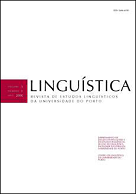The formation of the impersonal construction in Italian
Abstract
In Modern Italian, one can identify two independent reflexive (“si”) constructions which syntactically demote the lexical subject: a passive one and an impersonal one, with quite distinct properties. Old Italian only had passive si – the impersonal construction is the result of many small changes in the rules and the domain of application of the passive construction: these changes began in the Old Italian period and lasted for at least five centuries. But this new construction, not being the result of a unitary project, continues to show signs of being imperfectly put together. In this case study, syntactic change consists of (a series of) small, local changes which are the result of chance (external causes) or are brought about by the possible imperfections of the linguistic system (internal causes).
References
Câmara Jr., J. M. 1976. História e estrutura da língua portuguesa. Rio de Janeiro: Padrão.
Câmara Jr., J. M. 1975. História da lingüística. Petrópolis: Vozes. [1990].
Castro, I. et al. 1991. Curso de história da língua portuguesa. Lisboa: Universi- dade Aberta.
Castro, I. 2004. Introdução à história do português. 2 ed. Revista e ampliada. Lisboa: Colibri.
Chomsky, N. 1957. Syntatic Strutures. The Hague: Mouton.
Chomsky, N.; Halle, M. 1968. The Sound Pattern of English. New York: Harper and Row.
Coseriu, E. 1979. Sincronia, diacronia e história: o problema da mudança lingüística. Rio de Janeiro: Presença.
Foucault, M. 1972. Arqueologia das ciências e história dos sistemas de pensa- mento. Tradução de Elisa Monteiro. Rio de Janeiro: Forense Universitária. [2000].
Guedes, M.; Berlinck, R. 2000. E os preços eram commodos ... Anúncios em jornais brasileiros. Século XIX. São Paulo: Humanitas.
Hermann, P. 1880. Princípios fundamentais da história da língua. Lisboa: Gul- benkian. 1970.
Jakobson, R. 1931. Principes de phonologie historique. Paris: Klincksieck. [1964].
Joseph, B. D.; Janda, R. J. 2002. Handbook of historical linguistics. New York: Blackwell.
Labov, W. 1982. Building on empirical foundations. In: W. Lehmann; Y. Malkiel (Eds.). Perspectives in Historical Linguistics. Amsterdam: John Benjamins, 17-82.
Lass, R. 1997. Historical linguistics and language change. Cambridge: Cambridge University Press.
Lass, R. 1980. On explaining language change. Cambridge: Cambridge Univer- sity Press.
Lightfoot, D. 1979. Principles of diachronic syntax. Cambridge: Cambridge University Press.
Lobo, T. et al. 2001. Cartas baianas setecentistas. São Paulo: Humanitas.
Martinet, A. 1955. Économie des changements phonétiques: traité de phonologie diachonique. Bern: Francke.
Massini-Cagliari, G. 1999. Do poético ao lingüístico no ritmo dos trovadores: três momentos da história do acento. Araraquara: Cultura Acadêmica Editora UNESP.
Meillet, A. 1912. L’evolution des formes grammaticales. In: A. Meillet (1958). Linguistique historique et linguistique générale. Paris: Klincksieck.
Nunes de Leão, D. 1606. Ortografia e origem da língua portuguesa. Edição de M. L. C. Buescu. Lisboa: Imprensa Nacional – Casa da Moeda. [1983].
Roberts, I.; Kato, M. (Orgs., 1993). Português Brasileiro: uma viagem diacrônica. Campinas: Editora da UNICAMP.
Sapir, E. 1921. A linguagem: uma introdução ao estudo da fala. 2 ed. Rio de Janeiro: Acadêmico. [1971].
Schendl, H. 2001. Historical linguistics. Oxford: Oxford University Press.
Schuchardt, H. 1928. Brevier: ein vademecum der allgemein Sprachwissenschaft. 2 ed. Harle.
Silva Neto, S. 1976. História da língua portuguesa. Rio de Janeiro: Livros de Portugal.
Tarallo, F. 1990. Tempos lingüísticos: itinerário histórico da língua portuguesa. São Paulo: Ática.
Teyssier, P. 1980. História da língua portuguesa. São Paulo: Martins Fontes. 2004.
Weinreich, U.; Labov, W.; Herzog, M. 1968. Empirical foundations for a theory of language change. In: W. Lehman; Y. Malkiel (Eds.). Directions for Historical Linguistics. Austin: University of Texas Press, 95-188.
Downloads
Published
Issue
Section
License
Copyright (c) 2018 Linguística Revista de Estudos Linguísticos da Universidade do Porto

This work is licensed under a Creative Commons Attribution-NonCommercial 4.0 International License.



